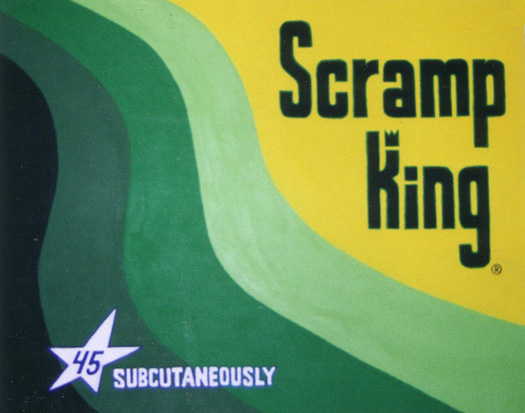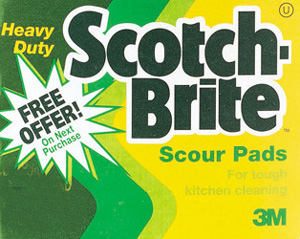Well you’re in your little room, and you’re working on something good.
But if it’s really good, you’re gonna need a bigger room.
And when you’re in the bigger room, you might not know what to do.
You might have to think of how you got started, sitting in your little room.
— The White Stripes, “Little Room”
Twenty years ago this week, I painted my first painting. The experience of making that first work is something that I shall vividly remember. While I have made hundreds of paintings in the decades since, no other artistic experience I’ve had can quite match the feeling of adventure and freedom I felt when I was first starting out.

Scramp King, my first painting, which I painted in late December 1994.
Back then, I was a senior-year English major who wrote poetry and considering a career as an English teacher. Despite my stated ambitions, I found myself spending countless hours in the art section of my school’s library, transfixed by one art history book after another.
One title stood out: Andy Warhol: A Retrospective. I couldn’t put that book down! I had fallen in love with Warhol’s early advertising paintings — of household appliances of vacuums, drills, and refrigerators depicted in newspaper ads. In these seemingly unfinished portraits on canvas, everyday products were exalted.
Before returning home for Christmas break, I took out a loan for the Warhol retrospective catalog. I consulted that book continuously throughout vacation, each time feeling emboldened to start my own journey as a painter.
One night following Christmas, I took the plunge into making art. With images of Warhol’s paintings and a painting idea of my own glowing in my brain, I wandered into my mom’s art studio, tore the shrinkwrap from a pre-stretched canvas, grabbed some tubes of acrylic paint and a brush, and embarked upon realizing an idea for a painting that I had carried with me for more than a year: the wrapper of a 3M Scotch Brite sponge. Thing is, this new painting wouldn’t say Scotch Brite. I wanted it to say Scramp King! This was to be a portrait of a product that could exist only in a parallel universe!

In the mid-1990s, Scotch Brite scouring sponges looked something like this. A wrapper that looked similar to this provided the source of inspiration for Scramp King.
Where did Scramp King come from? In the summer of 1993, I worked as a groundskeeper at an apartment complex. One project was to wash tenants’ front doors with Scotch Brite scouring sponges. (Man, were they abrasive! I scratched the heck out of quite a few doors!) In the process of removing dirt (and paint), the word “scramp king” jumped from a sponge’s wrapper into my brain, after I misread the packaging out of the corner of my eye.
That first painting seemed like such a transgressive act. It wasn’t the subject matter that was transgressive. It’s that I was a literature major who had never taken a studio art class — just a few art history classes. To me, painting is what studio art majors did! I felt like I wasn’t supposed to be painting. And yet, there I was, painting (straight out of tubes!) and working my way through a painting. I was taking a step toward becoming who I am.
Back at school, my friends told me they actually thought my painting was cool, and encouraged me to keep painting. Slowly, over time, I did just that. My confidence grew. But I never did take a studio art class. (Perhaps it shows!)
Reflecting upon what I have learned over the past two decades, a few lessons stand out. If I could go back in time and give myself advice, I’d probably tell myself the following five things:
1. If you want to make art, then make art! It’s that simple! You don’t need anyone’s permission or approval. Just make.
2. Never allow anyone talk you out of giving yourself to your art. I can’t tell you how important learning this lesson has been. People very close to me tried to convince me that devoting myself to my art was a kind of a selfish waste of time, that I’d struggle financially if I were to devote my life to making art. I was told I’d never make a living at it, and I’d be better off focusing on a career that made money. Unfortunately, at pivotal times, I listened to these people. But guess what? They were all wrong! The naysayers could never understand the bliss of having a great idea for a new painting, then finding a path to realizing it.
3. Take your work seriously, but don’t take yourself too seriously. Creative successes may come along — especially when you least expect them — and your visual agenda might be validated by a curator, gallery owner, or collector now and then. It’s nice to be recognized. But whatever happens, don’t believe your own hype! Stay humble. You’re only as good as your next painting.
4. Make art for yourself. For me, the true test of a work is whether I’m able to live with it on a daily basis. That said, making art with other people in mind doesn’t work for me. The applause or indifference of others is irrelevant. And don’t hope for others to like your work. If comrades or critics don’t like something you make, so be it. When you make art for yourself, the conversation surrounding the finished work is a separate matter. If something good happens, it’s bonus-round material.
5. Don’t compare yourself to other artists. And don’t compare your situation to that of other artists. As Theodore Roosevelt wrote, “Comparison is the thief of joy.” We sometimes read about artists who have ascended to international fame and fortune, or sell their work for ridiculous sums. Don’t let their success discount your self-opinion. Just because another artist seems to be “successful,” that doesn’t mean you can’t be, too. Keep believing in your gift. When in doubt, revisit point #4 above.
But ultimately, when I look back on 20 years of painting, I feel gratitude. I am grateful for having had the time, space, and gift of health to be able to make what I’ve made. I am grateful to my mom for allowing me to “borrow” her art supplies during Christmas break 1994, and to my sister who taught me how to mix paint. I am grateful to all of the fellow artists, friends, loved ones, collectors, and curators who have believed in my talent, and have supported me over time.
Being an artist can be a crazy calling to have. But I wouldn’t trade it for anything. Here’s to 20 more years!
— Grant Wiggins